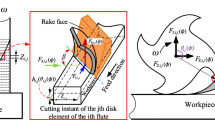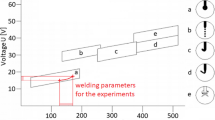Abstract
Taper-cutting is a common application of the wire electrical discharge machining (WEDM) process used for the production of parts with complex geometry such as extrusion dies in wear-resistant materials, cutting dies, etc. During cutting, the wire is subject to deformation, resulting in deviations in the inclination angle of machined parts. This fact causes dimensional errors and loss of tolerances that can lead to the rejection of high added-value tooling. Currently, WEDM machine manufacturers propose time-consuming experimental trial-and-error methodologies for the correction of the errors. To reduce the experimental load and to contribute a more general approach to the problem, two original models for the prediction of angular error in WEDM taper-cutting are presented here. Results show that part thickness and taper angle are the most influencing variables in the problem. Experimental validation of the proposed models shows that angular error can be reduced below 3′45′′ in 75% of cases.
Similar content being viewed by others
References
Van Dijck F (1973) Physico-mathematical analysis of the electro-discharge process. Ph. D. Thesis, K.U. Leuven
Dekeyser WL, Snoeys R (1989) Geometrical accuracy of wire EDM. Int. Symposium on Electro Machining (ISEM) IX, 226–232
Dauw DF, Beltrami I (1994) High-precision wire EDM by on-line wire position control. Annals of the CIRP, 43/1/94, 193–197
Han F, Kunieda M, Sendai T, Imai Y (2002) Simulation on influence of electrostatic force on machining characteristics in WEDM. Int J Electr Mach 7:31–36
Magara T, Yamada H, Yatomi T, Kobayashi K (1994) Study on improvement of surface straightness in wire EDM. Precis Eng 16(2):156–161
Dauw DF, Sthioul H, Delpretti R, Tricarico C (1989) Wire analysis and control for precision EDM cutting. Annals of the CIRP, 38/1/89, 191–194
Sthioul H, Delpretti R, Tricarico C, Dauw DF (1989). Improvement of the wire EDM cutting precision by vibration analysis and control. Int. Symposium on Electro Machining (ISEM) IX, 214–218.
Yamada H, Mohri N, Saito N, Magara T, Furutani K (1997) Modal analysis of wire electrode vibration in wire-EDM. Int J Electr Mach 2:19–24
Puri AB, Bhattacharyya B (2003) An analysis and optimisation of the geometrical inaccuracy due to the wire lag phenomenon in WEDM. Int J Mach Tools Manuf 43:151–159. doi:10.1016/S0890-6955(02)00158-X
Ravani B, Wang J (1991) Computer aided geometric design of line constructs. ASME J Mech. Des 113(4):363–371. doi:10.1115/1.2912791
Wang J, Ravani B (2003) Computer aided contouring operation for travelling wire electric discharge machining (EDM). Comput Aided Des 35:925–934. doi:10.1016/S0010-4485(02)00207-5
Richard J, Nguyen VK, Stroud I (2004) Standardisation of the manufacturing process: IMS/EU STEP-NC project on the wire EDM process, IMS Forum, part 2, 1197–1204
Hsue WJ, Su H (2004) Removal analysis of WEDM’s tapering process and its application to generation of precise conjugate surface. J Mater Process Technol 149:117–123. doi:10.1016/j.jmatprotec.2004.03.001
Chiu YY, Liao YS, Li HC, Sue PC (2007) Study of taper-cut machining of WEDM machine. Proc. of the 2nd Manufacturing Engineering Society International Conference, Madrid
Kinoshita N, Fukui M, Fujii T (1987) Study on wire-EDM: accuracy in taper-cut. Annals of the CIRP, 36/1/87, 119–122
Kinoshita M (1997) Control device for wire electric discharge machining with taper working correction function. Patent JP11165219A
Diamond WJ (1989) Practical Experiment Designs, 2nd edn. Van Nostrand Reinhold, New York
Sanchez JA, Plaza S, Lopez de Lacalle LN, Lamikiz A (2006) Computer simulation of wire EDM taper-cutting. Int J Comput Integr Manuf 19:727–735. doi:10.1080/09511920600628855
Author information
Authors and Affiliations
Corresponding author
Rights and permissions
About this article
Cite this article
Plaza, S., Ortega, N., Sanchez, J.A. et al. Original models for the prediction of angular error in wire-EDM taper-cutting. Int J Adv Manuf Technol 44, 529–538 (2009). https://doi.org/10.1007/s00170-008-1842-5
Received:
Accepted:
Published:
Issue Date:
DOI: https://doi.org/10.1007/s00170-008-1842-5




